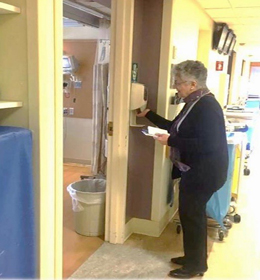
Beth Israel Deaconess Medical Center (BIDMC) in Boston, Massachusetts, has a long history of personalized patient care and community service, which now includes a program of inpatient rounding performed by patient and family advisors. Leaders of BIDMC’s Patient and Family Engagement team described the rounding program in a presentation to the Massachusetts Coalition for the Prevention of Medical Errors’annual Patient Safety Forum held on May 4, 2018.
BIDMC implemented Patient and Family Advisory Councils (PFAC) before hospitals in Massachusetts were mandated by state law to have PFACs in place by October 2010. BIDMC established a PFAC for its neonatal intensive care unit (ICU) in 2006 and for the adult ICU in 2007. BIDMC implemented a hospital-wide PFAC in 2010, the same year its Patient and Family Engagement team was established.
Patient and Family Advisors Solicit Direct Feedback
Patient and family advisors serve on BIDMC committees, participate in focus groups and special projects, and work on a number of advisory councils addressing issues across the system and within departments, such as intensive care.
A select group of advisors perform one-on-one rounding with inpatients, soliciting direct feedback about their care. These patient and family advisors are trained in rounding and provide a unique source of actionable information used by the Patient and Family Engagement team to help solve specific problems and improve care overall.
At the Patient Safety Forum, Caroline Moore, program leader for Patient and Family Engagement at BIDMC, described the rounding process:
A trained advisor goes to the floor to which he or she was assigned. They know ahead of time if there are any patients who should not be included in that day’s rounds.
The advisor goes door-to-door, introduces him- or herself, explains the process and asks to have a confidential, patient-to-patient conversation about the care experience.
The conversation is unscripted, but the advisor will attempt to gather information about specific aspects of the experience, for example, communication and care transitions. The advisor might ask a question or two to prompt conversation: How is the food? How was your experience getting from the emergency department to the floor?
If the patient or a family member asks for assistance or follow up, the advisor will speak with the resource nurse on the floor or contact the Patient and Family Engagement program leader immediately.
After rounds, the advisor fills out a web-based form that captures the feedback in the words of the patient or family member as much as possible, as well as the names of any care providers mentioned specifically for exemplary service. The program leader sends an eCard to that employee and his or her supervisor the same day if possible.
De-identified information based on patient comments is sent to the nurse director of the unit and other relevant departments and procedure areas. The data from patient and family advisor rounding is searchable and used for systems improvement and teaching.
Nicola Truppin has been as advisor in the rounding program since it began in 2015. She reports feeling confident that issues patients report to her during rounds will be addressed promptly. Truppin described a number of experiences she’s had during rounds that reveal both the variety of individual patient viewpoints and experiences as well as her own sensitivity and acumen. The questions and stories she hears from patients include details and perspectives they are unlikely to share with busy bedside caregivers. Advisor rounding provides information that the hospital might not otherwise receive, and if it did, it would be after the fact, as a complaint, when the opportunity to make things better was already gone.
Barbara Sarnoff Lee, senior director of Social Work and Patient and Family Engagement, points out that patient satisfaction surveys, such as the Hospital Consumer Assessment of Healthcare Providers and Systems, typically provide information weeks after the fact. In planning the rounding program, BIDMC anticipated that having a real-time window into the patient experience would help address individual needs and systemic issues in quality and safety. Lee finds that groups across the organization now recognize the value of the data gathered through patient and family advisor rounding. For example, it has been used recently to support a declaration-of-need application the medical center filed related to new construction plans.
This presentation was one of a number at the Patient Safety Forum that focused on patient and family engagement. Paula Griswold, executive director of the Mass. Coalition, is gratified the involvement of patients and family members in the Forum’s program has grown steadily in recent years. Griswold says, “They have such a crucial perspective and role in improving care.”




